- Lesson One: The Number One
- ... in Geometry
- ... in Nature
- ... in Culture
- "Uroboros" (related artwork by the author)
- "Creation" (related artwork by the author)
- Lesson Two: The Square Root of Two
- ... in Geometry
- ... in Nature, Part 1
- ... in Nature, Part 2
- ... in Culture, Part 1
- ... in Culture, Part 2
- "Duality" (related artwork by the author)
- Lesson Three: The Square Root of Three
- ... in Geometry
- ... in Nature
- ... in Culture
- "Vesica" (related artwork by the author)
- Lesson Four: Phi, or the Golden Proportion
- ... Intro, Part 2
- ... Intro, Part 3
- ... in Geometry
- ... in Nature
- ... in Nature, Part 2
- ... in Culture
- "The Flower of Phi" (related artwork by the author)
- Lesson Five: The Five Perfect Solids
- ... Intro, Part 2
- ... The Tetrahedron
- ... The Octahedron
- ... The Cube
- ... The Icosahedron
- ... The Dodecahedron
Representations of Duality in Human Culture
To begin our search for examples of the human culture's understanding of duality, we need look only so far as the book of Genesis in the Christian Bible. Adam and Eve themselves, as the original male and female figure of this mythology, could be said to represent the great duality, but instead we will turn to another, more apt expression in their story of how two-ness creates the material world.
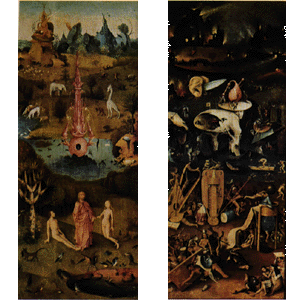 Heironymous Bosch's painting "The Garden of Delights"
Heironymous Bosch's painting "The Garden of Delights"As many of us know, Adam and Eve lived in the Garden of Eden (left), a paradisal realm that predated and was separate from the material world that we now live in. At the time of Eden, all of this wondrous land (including the two prototypal humans that lived there) exists wholly within Jehovah. In other words, they were existing in a state of unity. Jehovah, their creator who known more commonly today as simply "God," specifically forbade the two from eating the fruit of a specific tree in the Garden - that tree being named the Tree of Knowledge of Good and Evil.
According to Christian mythology, Eve becomes tempted into eating an apple from this tree by the snake known as Satan. In doing so she gains knowledge of good and evil, i.e., basic dualistic understanding in humans is born. As a direct reaction to this realization of dualistic opposition on Eve's behalf, Jehovah casts the two humans out of the garden, and thus the material world is created (right). It is undoubtedly no coincidence that Satan in this myth takes the form of a snake - the snake being considered representative of the forces of the material realm, as specifically opposed to the spiritual realm, in cultures spanning the globe.
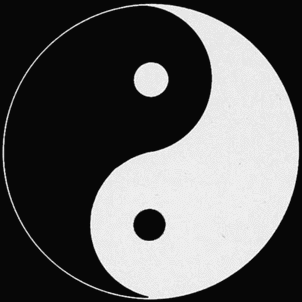 Taken From: CREDITS MISSING
Taken From: CREDITS MISSINGCertainly Western religion and mythology is not the only place that we find examples of Human culture's understanding of the ideas of duality. In fact, it could be said that Eastern cultures have accepted and worked more with the idea of duality than the Christian West ever did. One of the most popularized Eastern spiritual symbols is the Taoist Yin Yang (below left). This is a highly effective symbol which conveys not only the circle of unity divided into two equal yet opposing parts (black and white), but also shows that there can never be a state wherein on force totally dominates the other (note the black and white dots floating within their opposing color). Also note the sensation of rotational movement effected by the shapes of color themselves, which clearly suggests the motion caused within unity by the interplay of the two forces off of one another.
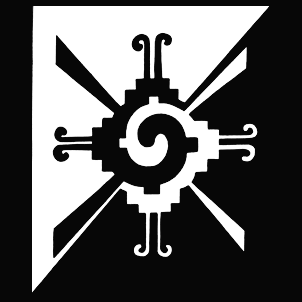 Taken From: Jose Arguelles book The Mayan Factor, Bear & Co., 1987
Taken From: Jose Arguelles book The Mayan Factor, Bear & Co., 1987An amazingly similar example is provided in the Hunab-Ku of the Central American Mayan culture. We find the same balance of black and white in the images, the same projection of one color into its mirrored and opposing half, and the same spiraling motion created by the shapes employed in the designed. That the two Taoist and Mayan symbols represent the same juxtaposition of dualistic forces is made obvious by the similarity of their designs. Bear in mind that the two cultures were separated by both time and great physical distance when these symbols were created.
The culture that created the yin yang also created a system of divination, or fortune telling, know as the I-Ching, or "Book of Changes." The Book of Changes is one of the most ancient texts known to the world, dating back over three thousand years. When one understands the straightforward and fundamental dualistic logic behind its workings, it is no surprise that it has survived down to, and is still applicable in, modern times.
The philosophy on which the I-Ching is based is an excellent example of how growth occurs once a basic duality is created from the division of unity. It also provides a clear explanation of how the number two implies the numbers in the power of two series (four, eight, sixteen, thirty-two, sixty-four, etc. ad infinitum). So in order to expand our vision and understanding of duality, let's take a closer look at the straightforward logic behind this most ancient of systems.
The I-Ching consists of sixty-four symbols, known as Hexagrams, each of which contains six horizontal lines, one stacked atop the other. Each one of the six horizontal lines can take one of two forms - either solid, representing Yang, or broken, representing Yin.
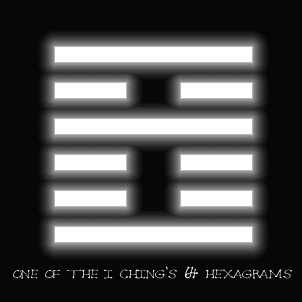 Original artwork created by A. O'Connor for Nature's Word using Adobe Photoshop 5.0.
Original artwork created by A. O'Connor for Nature's Word using Adobe Photoshop 5.0.The I-Ching is traditionally employed for divination. Those who use it as such do so by throwing sticks carved with symbols that represent the two opposing forces Yin and Yang. By skillfully reading the lay of the cast sticks, it is possible for the sage to ascertain what specific one of the sixty-four hexagrams best relates to the result of the throwing. Because it is believed that the sticks can only fall in such a pattern as would perfectly represent the moment in question, the meaning behind the particular hexagram is considered as intrinsically related to the question that has been asked. Some interpretation on the sage's behalf is common, and the questioner has his or her answer.
For our purposes, however, it is not so important to learn how the process of divination occurs as it is to note the fundamental dualistic logic upon which the sixty-four hexagram system is based.
For a moment let us forget the sixty-four Hexagrams, and start at the I-Ching's most basic level of understanding. The I-Ching, and indeed all of Taoism, starts with the idea that there is a single unified whole that encompasses everything that exists. However, within this unified whole, there is movement, and this movement is created by the workings of two fundamental forces, as we saw in the symbols of the Yin Yang and Hunab-Ku above. For the purposes of the I-Ching, the Yin Yang is translated into the two "I", or "Elementary Forms" - the solid line and the broken line. Each one of these lines represents one half of the basic duality created by the fundamental division of unity - a solid line representing the heavenly/masculine/positive force while a broken line represents the earthly/feminine/negative force. Keep in mind that masculine/feminine does not necessarily translate to male/female, and positive/negative is to be considered in the sense of electrical polarity, as opposed to the good/evil, right/wrong sense. Good/evil and right/wrong are far too open to personal interpretation to be considered on an archetypal or universal basis, and that is a very important point to remember throughout this tutorial (and one's life, for that matter).
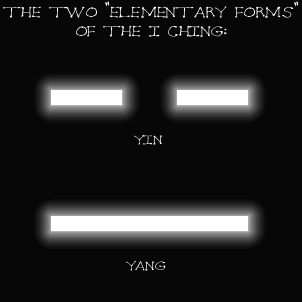 Original artwork created by A. O'Connor for Nature's Word using Adobe Photoshop 5.0.
Original artwork created by A. O'Connor for Nature's Word using Adobe Photoshop 5.0.The movement that we experience in the world around us is a result of the continuous opposition of the Elementary Forms working off of one another moment after successive moment. If we could ever break this tug-of-war between Yin and Yang into a moment by moment analysis, we would see that there are times at which Yin dominates, and times at which Yang has the upper hand. If we were to begin at the beginning of this struggle, there would be only one moment to analyze, and thus only one force that would dominate. This moment could be represented by one of the pictured symbols. As the next moment occurred, it is possible that the same force would dominate again, or that the other force would take control. Instead of simply representing the current moment with one of our two symbols above, we represent the history of the struggle, moment by moment, by adding the new dominating symbol on top of the symbol which dominated in the last moment. By doing so, we would derive one of the following symbols:
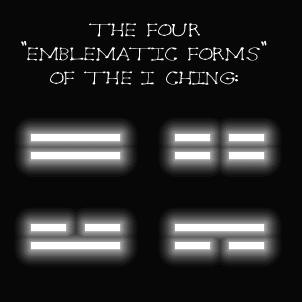 Original artwork created by A. O'Connor for Nature's Word using Adobe Photoshop 5.0.
Original artwork created by A. O'Connor for Nature's Word using Adobe Photoshop 5.0.Now Yin and Yang have worked off of one another twice, and four possible outcomes of their struggle have resulted. Note that two to the second power equals four. In the I-Ching, these four combinations are known as the "Hsiang", or "Emblematic Symbols," and could easily be likened to the Western four elements of Fire, Air, Earth , and Water.
Once again, the dualistic forces work off of themselves, and a third tier is added. This time, eight combinations are possible, and these eight possibilities are called the "Kwa", or "Trigrams." Note that Two to the third power equals eight.
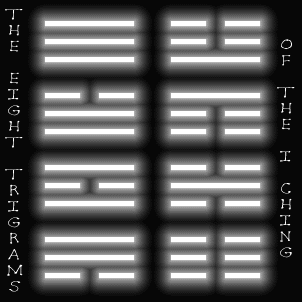 Original artwork created by A. O'Connor for Nature's Word using Adobe Photoshop 5.0.
Original artwork created by A. O'Connor for Nature's Word using Adobe Photoshop 5.0.And finally, the eight Trigrams are stacked one atop the other in every possible combination, giving us the sixty-four possible combinations. These sixty-four possible outcomes are the Hexagrams that this discussion started with. Note that two to the sixth power equals sixty-four.
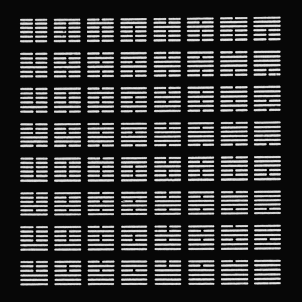 Taken From: CREDITS MISSING
Taken From: CREDITS MISSINGEffectively, the Taoists have mapped out the interplay of dualistic forces to a fairly complex level. Each one of the Hexagrams is understood to have an official interpretation which relates directly to the ways in which either of the two dualistic forces have successively dominated one another as the symbol progresses from bottom to top. Unfortunately for us Westerners, the interpretations must by necessity evoke greater archetypes in the reader, and this is only capable by using complex cultural references and paradoxical plays on words that will elicit the correct response from the observer. The unfortunate part about this is that the I-Ching's traditional interpretations are thus culturally bound to those who are born and raised in China. This is not to say that Westerners cannot glean any wisdom from the I-Ching, but more that in order to fully understand the depth of the I-Ching in its original context, an extremely in-depth knowledge of Chinese culture is required.
Some of the interpretations are quite obvious, however. Two such Hexagrams are known as "The Creative" (below left) and "The Receptive" (below right). The Creative consists of six Yang lines stacked one atop the other, and it is no surprise that it is considered to be the most heavenly/masculine/positive of all the Hexagrams. The Receptive, as can be seen, consists of the diametric opposite arrangement, with six Yin lines being stacked upon each other. The Receptive is, of course, considered to be the most earthly / feminine / negative of the Hexagrams.
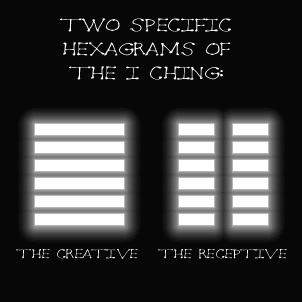 Original artwork created by A. O'Connor for Nature's Word using Adobe Photoshop 5.0.
Original artwork created by A. O'Connor for Nature's Word using Adobe Photoshop 5.0.To summarize, each of the sixty-four Hexagrams has a specific interpretation, recorded in the book known as the I-Ching. Some Hexagram, such as the two pictures at left, have interpretations which are fairly obvious due to the arrangement of forces which they are constituted of. But the interpretations of the those sixty-two Hexagrams which represent mixed forces of Yin and Yang become very complex and in-depth, as is easily imagined when it is considered that these symbols represent the two forces of duality working off of one another through six successive levels of recombination in every possible permutation.
If it is considered that much of human perception is grounded in dualistic understanding, then it becomes clear that the Taoists have effectively pinpointed sixty-four archetypes within every human's perception of his or her environment. It is even more fascinating to note that the Taoists had accomplished this precise systematic understanding of human perception thousands upon thousands of years before the area of scholastic study known as "psychology" ever existed.


